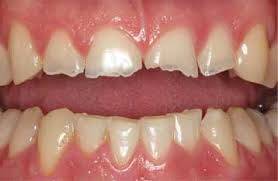Michigan Splint Thearpy
A MICHIGAN SPLINT
A Michigan Splint is an Oral Appliance that covers all the teeth in either the maxilla (upper jaw) or mandible (lower jaw) and is therefore termed a “full-coverage splint”. It is manufacture in a hard resin such as poly-methyl-methacrylate.
At NQ Surgical Dentistry the Michigan Splint is made of 3mm in thickness for a number of reasons. By being thick it remains strong and less liable to fracture when worn with the heavy bite forces applied. It has sufficient thickness to allow for careful spot grinding to customise the biting surface to achieve a truly even bite with contacts present around the entire arch, and sufficient thickness exists to retain splint material for the canine teeth to slide on when the mandible is moved sideways into what is called either left or right lateral excursions. In these sideways movements of the jaw, the posterior teeth should ideally be slightly apart while contact remains anteriorly in the canine region and thereby excessive lateral pressure on posterior teeth, fillings or crowns is avoided. This is what is called a “canine-protected occlusion”.
Finally the 3mm thickness of the splint results in the Condyl Head of the mandible (that part of the lower jaw making up the joint) hinging open and being minimally displaced anteriorly thereby taking pressure off the intra-articular disc (fibro-cellular tissue pad in the joint) and the posterior ligament both if which may have associated inflammation that contributes to pain.
INDICATIONS FOR MICHIGAN SPLINT THERAPY
Such a split can be used for a number of reasons although commonly they are used to protect the teeth from damage resulting from habitual tooth grinding, known as bruxism.
Bruxism is usually a stress-related habit adopted as part of the overall physiological stress-coping mechanism. Much of the bruxing activity takes place while the patient is asleep although it can also take place during the day and may be associated with particular activities including driving, using a computer, attending meetings or performing either intricate manual tasks or working out in the gym.
Full coverage splints are generally used for patients who grind while patients who clench are often successfully stabilized by a partial coverage splint.
Partial coverage splints can lead to unwanted tooth movement (read the article concerning NTI splint therapy) and therefore once the symptoms are controlled, it is best to provide a full coverage splint to maintain tooth positions. A Michigan splint is used for this purpose frequently in our practice.
COMPLICATING FACTORS WITH TOOTH GRINDING (BRUXISM)
While the forceful rubbing of tooth on tooth does lead to wearing away of the enamel, this damage can be far more severe still if the patient also suffers from gastro-oesophageal reflux disease (GORD). The Hydrochloric acid from the stomach should remain confined to the stomach but if the sphincter muscle at the base of the oesophagus is loose, the acid can leak  up the oesophagus and even small amounts leak into the mouth particularly when the patient is lying down. This acid then attacks the enamel of the teeth, softening the surface of the enamel. If bruxism then takes place this softened enamel is more easily ground off the tooth surface exaggerating the damage.
up the oesophagus and even small amounts leak into the mouth particularly when the patient is lying down. This acid then attacks the enamel of the teeth, softening the surface of the enamel. If bruxism then takes place this softened enamel is more easily ground off the tooth surface exaggerating the damage.
A similar “tooth dissolving” effect results if the patient habitually consumes acidic drinks or foods. By wearing a Michigan splint at night the tooth surfaces are protected and wear prevented.
Patients who grind their teeth should receive nutritional counseling to minimise the dietary impact of their foods and beverages on their dental health and if there is any suspicion that they suffer from GORD they should seek advice from their doctor.
CARE AT THE FITTING APPOINTMENT
When fitting full coverage splints it is imperative that the operator pays great attention to detail when adjusting the biting surface of the splint and carries out the adjustment of the surface with great attention to detail using the thinnest possible marking tape. Failure to accurately adjust the biting surface may not just prevent the splint from helping to reduce or resolve symptoms it can even make existing symptoms worse.
Accurate splint adjustment for full coverage splints will take around 30-45 minutes. A “Michigan-type” splint can be worn on either the upper or lower teeth with equal success, however, as in all joint and muscle therapy, success can never be guaranteed.
contact the friendly team at NQ Surgical Dentistry today on (07) 4725 1656 or call in to see us at 183 Kings Rd, Pimlico QLD 4812
BOOK AN APPOINTMENT
CALL US TODAY
07 4725 1656
